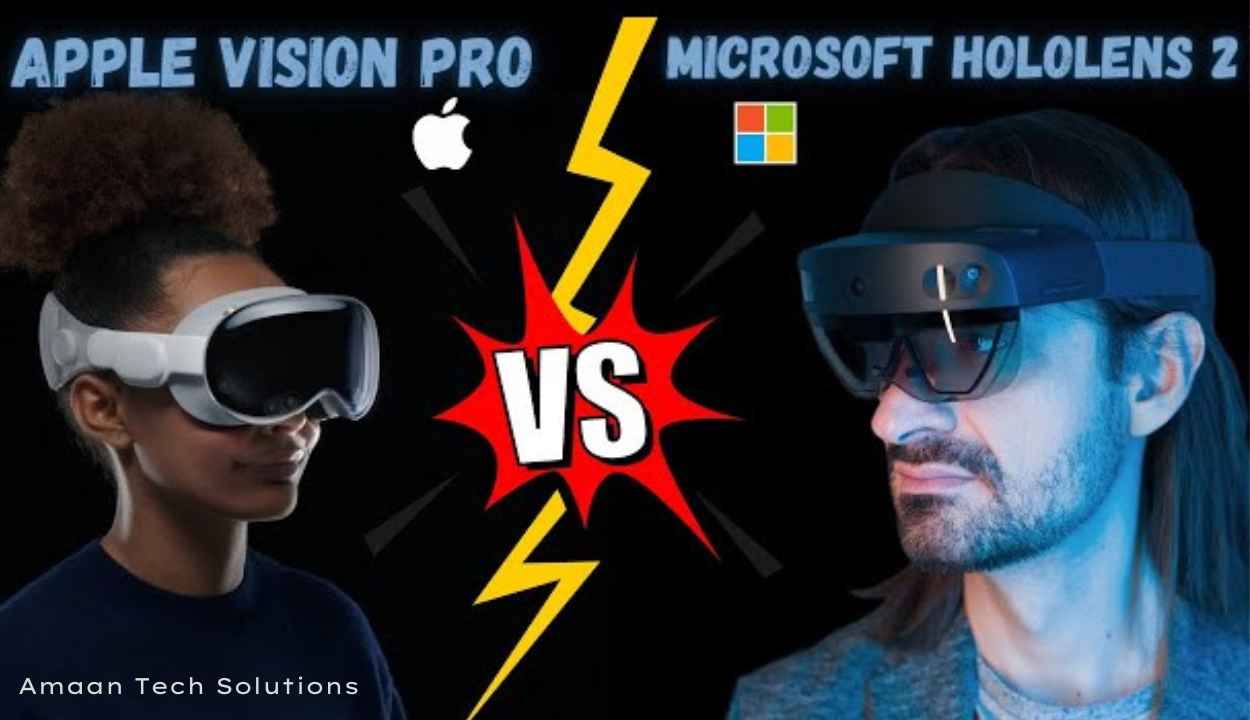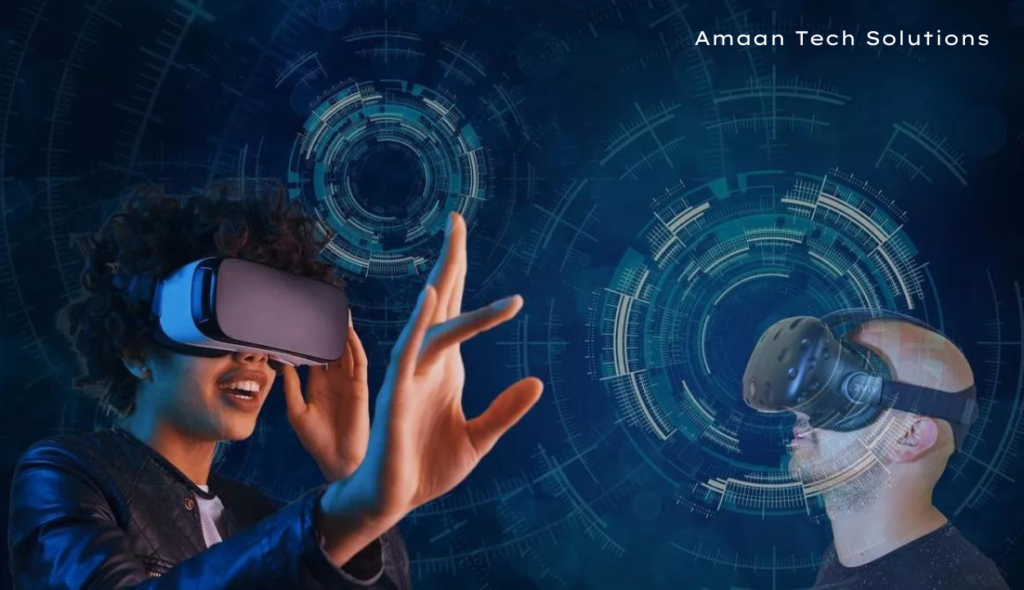
Introduction To Apple Vision Pro And HoloLens
Several core features and capabilities distinguish the two devices
In recent years, augmented reality (AR) and mixed reality (MR) technologies have made significant strides, with major tech companies like Apple and Microsoft leading the charge. Two of the most prominent devices in this space are Apple’s Vision Pro and Microsoft’s HoloLens. These innovative headsets blend the physical and digital worlds, offering new ways to interact with information, entertainment, and each other.
Apple Vision Pro
Apple Vision Pro is Apple’s first foray into the world of spatial computing, introducing a new era of interaction with digital content. Unveiled in 2023, Vision Pro is designed to integrate digital content seamlessly with the physical world. Unlike traditional VR headsets, Vision Pro prioritizes AR, enabling users to see and interact with digital elements overlaid on their real-world surroundings.
Key features of the Vision Pro include a high-resolution display system, advanced sensors for tracking eye movement and gestures, and a powerful M-series chip for processing complex tasks in real-time. Vision Pro also emphasizes comfort and usability, with a sleek design that fits comfortably on the head and intuitive controls that respond to natural gestures and voice commands.
The Vision Pro is designed not just for gaming but also for productivity, entertainment, and communication. It allows users to engage with apps in a three-dimensional space, create immersive experiences, and interact with virtual objects as if they were real. Apple’s integration of Vision Pro with its broader ecosystem of devices also ensures a seamless experience across all Apple products.
Microsoft HoloLens
Microsoft HoloLens, first introduced in 2016, was one of the earliest devices to bring mixed reality to the mainstream. HoloLens combines holographic computing with AR, allowing users to interact with digital content in a way that feels natural and integrated into their environment. The device is often hailed for its applications in professional settings, including healthcare, engineering, and education.
HoloLens features a transparent visor that displays digital overlays on the real world, enabling users to see and manipulate 3D holograms. It is equipped with an array of sensors, including depth cameras and spatial sound technology, which allow it to understand and map the environment. The HoloLens operates independently without needing to be tethered to a computer, thanks to its built-in processing unit.
One of the standout aspects of HoloLens is its enterprise focus. Microsoft has positioned HoloLens as a tool for professionals, with applications ranging from remote assistance and virtual collaboration to complex simulations and training programs. The device supports various software platforms, including Microsoft’s Azure cloud services, enhancing its capabilities in areas like AI and machine learning.
Display Quality
Apple Vision Pro enhances visual fidelity with its high-resolution dual Micro-OLED displays, ensuring vibrant and detailed visuals.
HoloLens offers a competent display yet lacks the refined resolution and color accuracy of the Vision Pro.
Processing Power
Apple Vision Pro utilizes state-of-the-art Apple silicon, ensuring high performance and energy efficiency.
HoloLens leverages its custom HPU for specific computational tasks, providing solid performance yet trailing in overall processing capabilities compared to Vision Pro.
Sensor Technology
Apple’s vast array of sensors offers a more immersive AR/VR experience due to advanced spatial awareness.
HoloLens incorporates essential sensors but may lag in terms of comprehensive spatial mapping.
Use Case Focus
Vision Pro appears targeted at high-end consumer and professional markets, with applications in gaming, media, and productivity.
HoloLens is primarily enterprise-focused, emphasizing industrial, educational, and medical applications.
Overall, both Apple Vision Pro and HoloLens demonstrate significant strides in AR and VR, each with unique strengths tailored to distinct market needs.
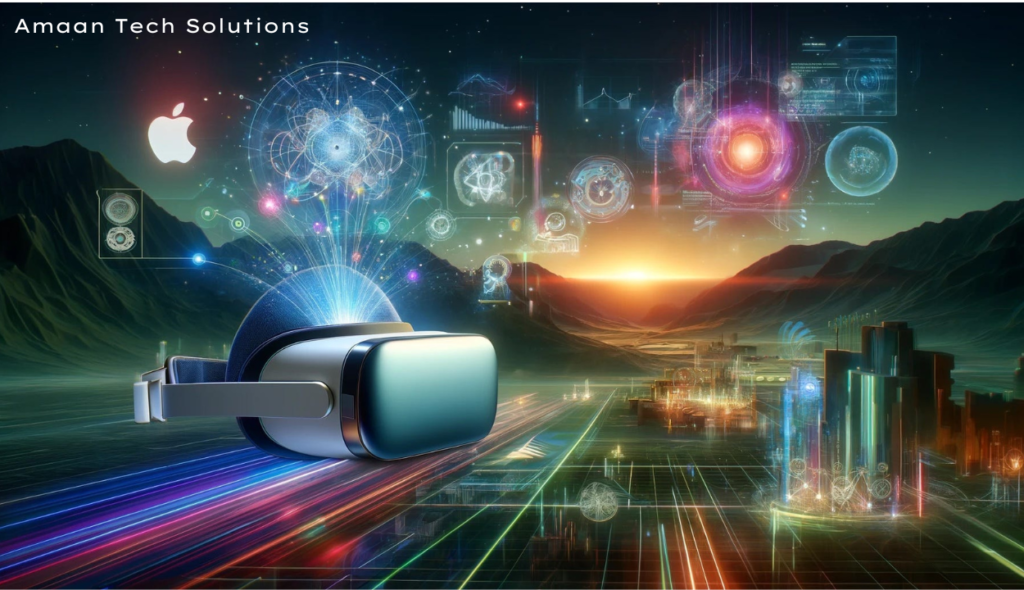
Design And Ergonomics Comparison
The Apple Vision Pro and HoloLens present distinct approaches to design and ergonomics, each emphasizing different aspects to enhance user experience.
Apple Vision Pro
- Aesthetics: Apple Vision Pro maintains Apple’s tradition of sleek, minimalist design. It features a lightweight aluminum frame, providing durability without compromising comfort.
- Comfort: Apple incorporates a soft inner padding and adjustable headband, ensuring the device fits securely on various head sizes and shapes. The materials used are breathable, reducing discomfort during extended use.
- Controls: The Vision Pro employs touch-sensitive surfaces and integrated gesture recognition for an intuitive control scheme. This hands-free interaction enhances ease of use and precision in virtual environments.
- Field of View (FOV): Apple Vision Pro offers a wide field of view, immersing the user more thoroughly in augmented reality experiences. The expansive FOV minimizes perceptual distortions and enhances peripheral awareness.
HoloLens
- Aesthetics: HoloLens, designed by Microsoft, combines functional design with modern aesthetics. The device has a more industrial look, with a focus on robustness and adjustability.
- Comfort: The HoloLens features an adjustable headband and padding that distribute weight evenly. While it is slightly bulkier than the Vision Pro, its design ensures balanced pressure points and reduces strain during prolonged use.
- Controls: HoloLens leverages a combination of voice commands, hand gestures, and gaze-tracking for control. This multimodal input system provides versatility and caters to various user preferences.
- Field of View (FOV): The field of view in HoloLens is slightly narrower compared to Vision Pro. However, it is sufficient for most augmented reality tasks, offering clear and well-defined visuals within its range.
Key Differences
- Material and Weight: Apple Vision Pro’s aluminum construction is lighter compared to the plastic and metal composite used in HoloLens, making it more comfortable for long-term wear.
- User Interface: Vision Pro emphasizes a more seamless and less invasive interaction with its touch and gesture controls, while HoloLens provides a more comprehensive suite of control options, including voice commands.
- FOV Range: Vision Pro’s wider field of view offers a more immersive experience, whereas HoloLens’ focused view enhances precision in professional and industrial applications.
In conclusion, the design and ergonomics of the Apple Vision Pro and HoloLens are tailored to different user needs and preferences, reflecting their underlying design philosophies and intended use cases.

Display And Visual Quality
When examining the display and visual quality of the Apple Vision Pro and HoloLens, several critical aspects come to light.
Apple Vision Pro sports high-resolution micro-OLED displays that provide an immersive visual experience. Each eye is treated to a 23 million-pixel display, delivering incredibly sharp and vibrant imagery. This results in stunning clarity and a realistic depiction of both augmented and virtual realities. The display also supports a wide color gamut, ensuring true-to-life colors and deep contrasts.
Meanwhile, Microsoft’s HoloLens utilizes waveguide technology in its display system. The HoloLens 2 features 2K 3:2 light engines, delivering a total of 47 pixels per degree. Users benefit from more noticeable clarity and improved visual overlays. This technology allows for effective blending of digital content with the real world, offering a seamless mixed reality experience. Additionally, HoloLens employs automatic pupillary distance adjustment to ensure comfort over extended usage periods.
Field Of View
The field of view is another critical element where these devices differ. Apple Vision Pro has a field of view designed to encapsulate the user more effectively, offering a more extensive and encompassing visual area. This offers a sense of immersion that can be pivotal for applications ranging from entertainment to professional use.
HoloLens has a field of view of approximately 52 degrees diagonal. While this is less expansive than Apple’s offering, it is optimized for enterprise environments where a balance between immersion and awareness of the real world is crucial.
Brightness And Adjustments
Brightness and adjustability are significant factors affecting visual performance. Apple Vision Pro incorporates adaptive brightness to dynamically adjust to various lighting conditions, enhancing user comfort and visual stability. Additionally, the system supports various customizable settings to fine-tune the visual experience according to the user’s preferences.
In contrast, HoloLens utilizes a consistent brightness system designed to cater to indoor and controlled lighting environments. While it may not dynamically adjust to changing conditions as efficiently as the Vision Pro, it offers a stable viewing experience suitable for its intended use cases.
Eye-Tracking And Interaction
Eye-tracking capabilities highlight another area of distinction. The Apple Vision Pro includes advanced eye-tracking software, enabling intuitive navigation and interaction within the virtual environment. This contributes significantly to user immersion and responsiveness.
Similarly, HoloLens incorporates eye-tracking technology but also emphasizes hand gestures and voice commands, providing a multi-modal interaction framework. This versatility makes HoloLens particularly suitable for complex professional applications requiring varied input methods.
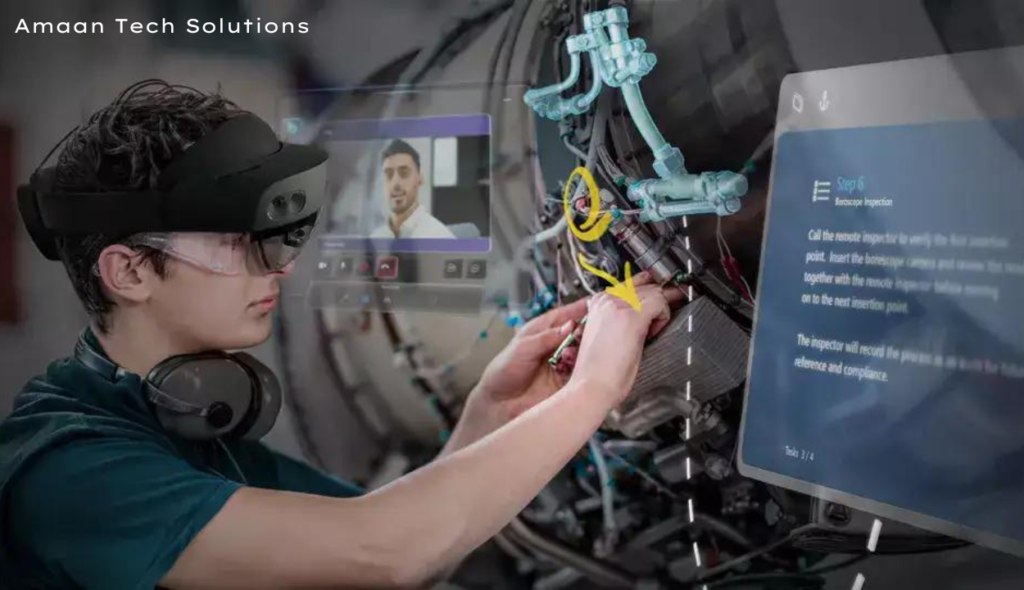
Performance And Processing Power
When comparing the performance and processing power of the Apple Vision Pro and Microsoft HoloLens, several key factors come into play.
Apple Vision Pro
- Processor: The Apple Vision Pro features Apple’s proprietary silicon chips, known for their high performance and energy efficiency. Typically, these may include an advanced iteration of the M1 or M2 chip series.
- Graphics: Apple integrates its own graphics processing units (GPU), ensuring peak graphical performance optimized for their hardware ecosystem.
- Memory: Enhanced with high-speed RAM, the Vision Pro supports seamless multitasking and swift app launches.
- Operating System: Running on a variant of Apple’s complex yet user-friendly operating system, it optimizes resource allocation for demanding augmented reality (AR) and virtual reality (VR) applications.
- Battery Life: While detailed specifications may vary, Apple devices traditionally offer balanced battery performance to support long AR/VR sessions.
Microsoft HoloLens
- Processor: The HoloLens 2 is powered by the Qualcomm Snapdragon 850, a robust mobile processor offering solid performance in AR applications.
- Graphics: Integrated graphics are specifically designed to handle real-time 3D rendering essential for mixed reality experiences.
- Memory: Equipped with 4GB of RAM, the HoloLens 2 ensures efficient data processing but may be outpaced by newer competitors in memory capacity.
- Operating System: Running on a custom version of Windows, this system is tailored for productivity in mixed reality, leveraging Microsoft’s ecosystem.
- Battery Life: Focused on enterprise use, HoloLens provides several hours of continuous use, optimized for business and industrial applications.
Comparative Aspects
- Processor Advantage: Apple has the edge with its advanced M-series chips, surpassing Snapdragon 850 in raw computational power and efficiency.
- Graphics Handling: Apple’s integrated GPU might provide smoother, more detailed visuals due to tighter hardware-software integration.
- Memory and Multitasking: Apple’s higher RAM capacity is likely to offer superior multitasking and faster data access.
- Ecosystem Integration: While HoloLens excels in enterprise environments with Windows integration, Vision Pro’s ecosystem is adeptly aligned for creative and mobile applications.
In summary, the Apple Vision Pro typically showcases superior silicon performance and efficiency, beneficial for intensive applications and extended use, whereas the HoloLens 2, with its reliable Qualcomm processor, caters well to enterprise needs with satisfactory battery endurance and effective graphics rendering capabilities.

Augmented Reality Features And Capabilities
Apple Vision Pro AR Capabilities
The Apple Vision Pro leverages advanced LiDAR technology and sensors to deliver precise AR experiences. Its key features include:
- Environmental Mapping: Utilizes LiDAR for 3D mapping of physical spaces, providing accurate and context-aware AR overlays.
- Object Recognition: Identifies and tracks objects within the environment, allowing for dynamic interactions and overlays directly onto real-world objects.
- Spatial Audio: Integrates spatial audio to align sound with virtual objects, enhancing immersive experiences.
- Eye Tracking: Employs eye-tracking sensors for intuitive interaction and navigation within AR content.
- Passthrough Technology: Delivers high-quality, real-time passthrough visuals that blend virtual and physical environments seamlessly.
- Gesture Control: Supports advanced hand-tracking for intuitive gesture-based controls, reducing the need for external controllers.
HoloLens AR Capabilities
Microsoft’s HoloLens features a robust set of AR capabilities, leveraging a suite of sensors and Holographic Processing Unit. Key features include:
- Spatial Mapping: Utilizes depth sensors to create detailed spatial maps, enabling accurate placement of holograms in the real world.
- Hand Tracking: Provides sophisticated hand-tracking capabilities, allowing users to interact with holograms through natural movements.
- Voice Commands: Integrates with Microsoft Cortana for voice-activated controls, facilitating hands-free operation.
- Rapid Calibration: Quick environmental scanning ensures immediate and precise AR content placement.
- Holographic Visualization: Achieves high-quality holographic displays with a wide field of view, enhancing immersive experiences.
- Multi-user Collaboration: Supports shared experiences and collaboration in a single AR environment, essential for enterprise applications.
Comparative Insights
When contrasting the Apple Vision Pro with the HoloLens:
- Precision: Vision Pro’s LiDAR-driven mapping offers heightened object recognition and interaction accuracy.
- Immersion: Both devices provide a rich, immersive experience, but Vision Pro edges out with finer spatial audio integration.
- Interaction: HoloLens excels in collaborative uses with its multi-user capabilities, whereas Vision Pro focuses on individual precision and immersive feedback.
- Ease of Use: Vision Pro’s eye-tracking and gesture control streamline user interaction, while HoloLens leverages voice commands effectively for hands-free operations.
The integration of cutting-edge AR technologies in both devices illustrates a significant leap in augmented reality, catering to a variety of use cases from enterprise solutions to individual immersive experiences.
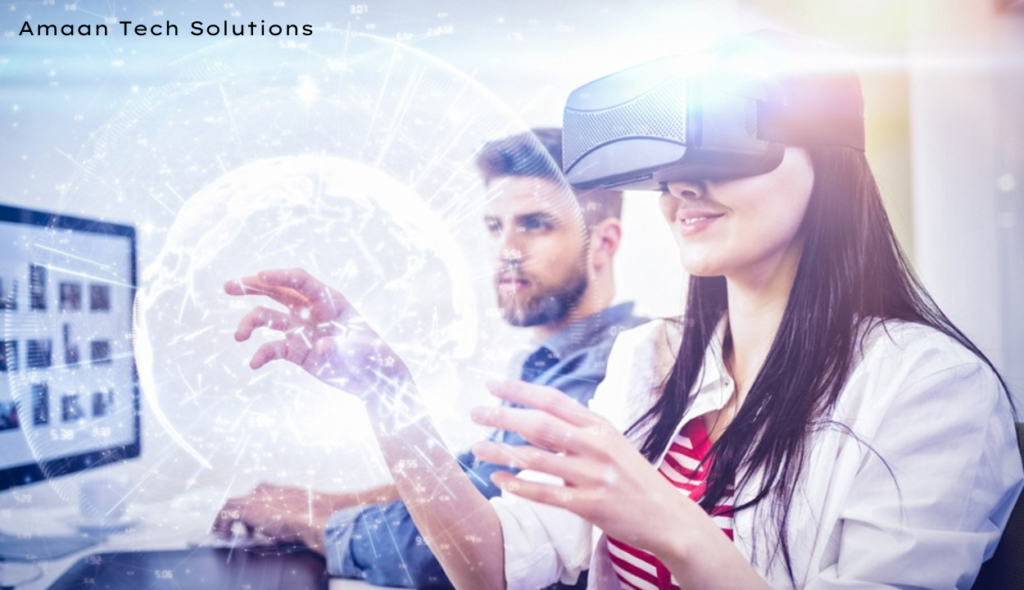
User Interface And Usability
The user interface (UI) and usability are critical factors in assessing augmented reality (AR) devices. Both Apple Vision Pro and HoloLens have unique approaches that cater to diverse user preferences and applications.
Apple Vision Pro
- Design Aesthetics: Apple Vision Pro offers a sleek, minimalist design, adhering to Apple’s tradition of aesthetic excellence. The device is lightweight and comfortable to wear for extended periods.
- Interaction Methods: The Vision Pro utilizes a blend of touch, voice commands, and gaze control, providing a seamless and intuitive user experience. Apple’s proprietary gesture controls, combined with voice activation via Siri, allow for quick and responsive interaction.
- Display Quality: Featuring high-resolution displays with exceptional color accuracy and brightness, the Vision Pro ensures that virtual elements blend seamlessly with the real world.
- Software Ecosystem: Apple’s cohesive ecosystem enhances usability. Users benefit from seamless integration with iOS applications, ensuring a familiar interface and straightforward navigation.
- Accessibility Features: Apple has incorporated advanced accessibility features, including voice-over, magnification, and customizable gestures, making the device usable for a broad audience.
HoloLens
- Ergonomic Design: HoloLens offers an ergonomic design focused on balancing weight distribution and comfort. The adjustable headband ensures a secure fit for diverse head sizes.
- Interaction Methods: Utilizing a combination of hand gestures, voice commands, and eye tracking, HoloLens provides a robust interaction experience. The incorporation of Microsoft’s Cortana enhances voice command functionality.
- Display Quality: While not as high in resolution as the Vision Pro, HoloLens offers solid display performance with an excellent field of view, supporting high-quality holographic projections.
- Software Ecosystem: HoloLens runs a specialized version of Windows, allowing compatibility with a variety of Windows applications. The cloud integration with Microsoft Azure enhances its enterprise usability.
- Accessibility Features: Features such as speech recognition, hologram broadcasting, and adjustable font sizes contribute to its accessibility. Developers can also build custom applications to cater to specific accessibility needs.
Comparative Usability
- Ease of Use: Apple Vision Pro is designed with an emphasis on simplicity and ease of use, aligning with Apple’s broader product philosophy. HoloLens balances ease with functionality, catering primarily to enterprise users.
- Customization: Both devices offer a range of customization options, though Apple Vision Pro is more consumer-focused, while HoloLens provides extensive customization for industrial applications.
- Learning Curve: HoloLens may present a steeper learning curve due to its advanced features targeted at professional and enterprise use, whereas the Vision Pro’s interface is more immediately intuitive.
By analyzing the various components of UI and usability, it is evident that both Apple Vision Pro and HoloLens excel in their respective domains, catering to different user needs and preferences.

Application And Developer Ecosystem
The application and developer ecosystem is a critical factor in evaluating AR/VR platforms like the Apple Vision Pro and Microsoft HoloLens.
Apple Vision Pro
Apple Vision Pro caters to a robust ecosystem driven by the existing iOS and macOS platforms.
- Developer Resources: Apple offers extensive resources via Xcode and the ARKit framework, enabling developers to create immersive applications seamlessly.
- App Store Integration: Apple Vision Pro benefits from seamless integration with the existing App Store, offering a ready-made distribution channel for AR applications.
- Developer Community: The large developer community for iOS and macOS translates to a wealth of forums, tutorials, and support networks that encourage innovation and ease of learning.
- Third-Party Apps: Numerous third-party applications are anticipated due to the high adoption rate and strong development incentives, fostering a rich ecosystem of diverse apps.
- Updates and Support: Regular updates and support from Apple ensure that developers have access to the latest features and security enhancements, promoting a dynamic development environment.
Microsoft HoloLens
Microsoft HoloLens prioritizes enterprise-level use with its ecosystem built around the Windows Mixed Reality platform.
- Developer Tools: Developers leverage tools like Visual Studio and the Mixed Reality Toolkit (MRTK) for creating applications, supported by Microsoft’s Azure cloud services for connectivity and processing power.
- Marketplace Access: The Microsoft Store provides a venue for distributing applications, though the focus skews more toward professional and industrial applications than consumer apps.
- Enterprise Solutions: HoloLens is often used to develop solutions for industries such as healthcare, manufacturing, and education, with applications tailored to support specialized use cases.
- Community and Support: Though smaller than Apple’s, the developer community around HoloLens is robust and enterprise-focused. Microsoft’s contributions to open-source projects also encourage collaboration and sharing of best practices.
- Continuous Development: HoloLens benefits from a continuous development cycle that aligns with Microsoft’s broader updates to Windows and its cloud services, ensuring sustained innovation.
The contrasting ecosystems reflect the distinct target markets and development philosophies of Apple Vision Pro and HoloLens, significant factors for developers considering which platform to invest in.

Battery Life And Power Consumption
Battery life and power consumption are critical factors to consider when comparing Apple Vision Pro and HoloLens. Both devices aim to deliver high performance while ensuring sustainability and efficiency.
Apple Vision Pro
- Battery Capacity: Apple Vision Pro features a powerful, integrated battery.
- Usage Time: The device promises up to 5 hours of continuous use on a single charge.
- Charging: It supports fast charging with an included USB-C charger.
- Power Management: Apple employs advanced power management techniques to optimize performance and extend battery life.
- Energy Efficiency: Uses Apple’s proprietary low-power silicon architecture for enhanced efficiency.
HoloLens
- Battery Capacity: HoloLens is equipped with a robust battery designed for extended use.
- Usage Time: Microsoft states that HoloLens can last up to 3 hours of active use.
- Charging: Features a magnetic USB cable for charging, enabling a full charge in approximately 2 hours.
- Power Management: HoloLens includes multiple power-saving modes to prolong battery life.
- Energy Efficiency: Utilizes custom-built processors to optimize energy consumption and maintain performance.
Comparative Analysis
- Battery Life: Apple Vision Pro offers longer battery life with up to 5 hours compared to HoloLens’s 3 hours.
- Charging Speed: Both devices support fast charging, but Apple Vision Pro includes a fast USB-C charger, whereas HoloLens uses a magnetic USB cable.
- Power Management: Both devices have advanced power management systems to maximize efficiency and performance; however, Apple’s proprietary low-power silicon architecture offers a slight edge.
- Energy Efficiency: Apple’s design focuses heavily on energy-efficient silicon, whereas HoloLens relies on custom processors to balance power consumption and performance.
User Experience
- Continuous Use: Users of Apple Vision Pro benefit from longer uninterrupted sessions, which is especially important for extended applications such as virtual collaboration or training.
- Charging Convenience: Both devices provide convenient charging options, but Apple Vision Pro’s fast charging ensures quicker readiness for prolonged use.
- Efficiency: Both brands emphasize energy efficiency, though the implementation strategies differ. Apple’s bespoke architecture allows for a seamless blend of power and efficiency, whereas HoloLens focuses on processor optimization.
Both Apple Vision Pro and HoloLens offer robust solutions for various use cases, with substantial provisions for battery life and power consumption.
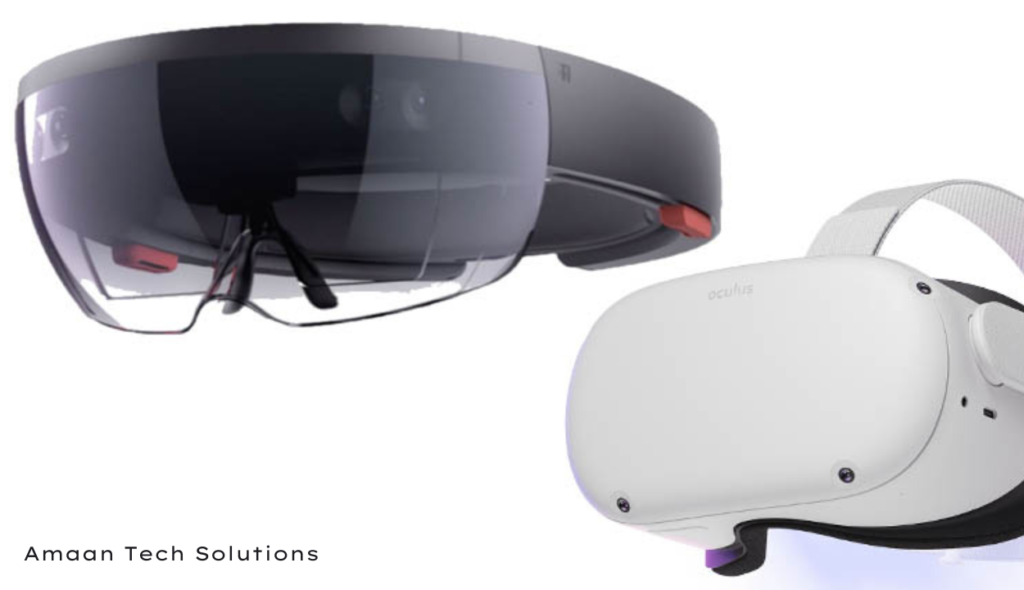
Pricing And Value For Money
When it comes to pricing, the Apple Vision Pro and Microsoft HoloLens cater to different segments of the market, influenced by their distinct capabilities, target users, and value propositions.
Apple Vision Pro
Apple has positioned the Vision Pro as a high-end product, reflecting its robust features and state-of-the-art technology.
- Base Model Price: The base model starts at approximately $3,000, placing it in the premium tier.
- Features to Justify Cost: High-resolution displays, advanced sensors, and seamless integration with the Apple ecosystem justify the elevated price point.
- Target Audience: Primarily targeted at professional developers, businesses involved in advanced visualizations, and consumers desiring top-tier AR experiences.
Microsoft HoloLens
Microsoft’s HoloLens is also a premium device but is priced somewhat differently to appeal to enterprise users and specialized sectors.
- Base Model Price: The HoloLens 2 is priced around $3,500.
- Features that Add Value: Enhanced interaction with holograms, improved comfort, and extensive enterprise support add significant value.
- Target Audience: Geared towards industries such as healthcare, manufacturing, and education, focusing on use cases like training, field service, and 3D modeling.
Comparative Analysis
Pricing Metrics
- Apple Vision Pro: Competitive pricing in the consumer-facing high-end AR market, integrating sophisticated features that appeal to tech enthusiasts and developers alike.
- Microsoft HoloLens: The pricing reflects its focus on enterprise solutions with robust industrial applications.
Value For Money
- Hardware Quality: Both devices offer impeccable hardware quality; however, Apple Vision Pro edges out with higher resolution displays and a more immersive user interface.
- Software Ecosystem: HoloLens excels in enterprise adaptability with extensive support for Microsoft applications like Dynamics 365 and Azure. Vision Pro, tied into the Apple ecosystem, provides seamless operation for users already embedded within Apple’s product ecosystem.
- Support and Longevity: Both companies provide substantial support, yet Microsoft’s alignment towards enterprises offers more extended operational support cycles.
By considering initial investments against potential productivity gains and workflow enhancements, businesses can evaluate which device offers better value for their specific needs.
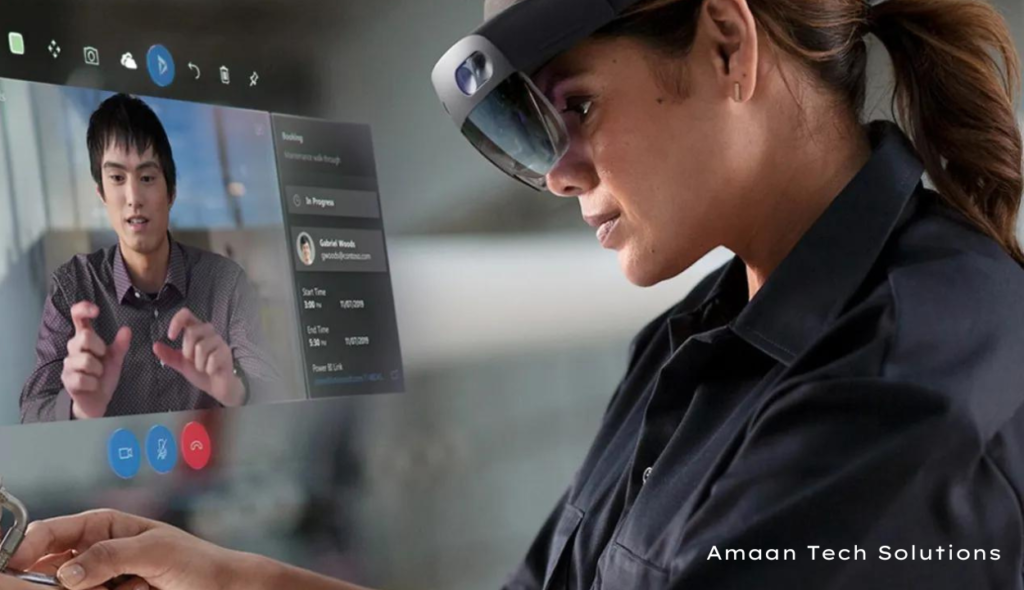
Industry Applications And Use Cases
Healthcare
Apple Vision Pro
- Medical Imaging: The Apple Vision Pro’s high-resolution display aids radiologists and surgeons, providing clear images during critical procedures.
- Remote Consultation: It supports remote consultations, allowing doctors to view detailed patient data and interact with other healthcare professionals seamlessly.
- Training: Medical students can benefit from immersive simulations of surgeries and medical procedures, enhancing their learning experience.
HoloLens
- Surgical Assistance: HoloLens offers augmented reality overlays, assisting surgeons with real-time data and enhances precision during operations.
- Patient Rehabilitation: It helps in physiotherapy, guiding patients through exercises with visual cues and monitoring progress.
- Medical Education: HoloLens provides detailed 3D anatomical models, assisting in complex medical training and education.
Manufacturing
Apple Vision Pro
- Quality Control: The Vision Pro’s detailed visuals assist in inspecting manufactured products, ensuring high-quality standards.
- Training: Workers can use immersive training modules to learn complex machinery operations, improving efficiency and safety.
- Remote Assistance: Technicians can collaborate with remote experts in real-time, diagnosing and solving machinery issues promptly.
HoloLens
- Assembly Line Assistance: HoloLens provides step-by-step holographic guidance, enhancing accuracy and speed in assembly processes.
- Maintenance: It aids in machinery maintenance, with interactive 3D instructions and real-time expert support.
- Design and Prototyping: Engineers can visualize and manipulate 3D models, facilitating iterative design processes and reducing errors.

Apple Vision Pro
Virtual Classrooms
Vision Pro facilitates immersive virtual classrooms, enhancing remote learning experiences.
Interactive Learning
It transforms traditional lessons into engaging, interactive learning modules, improving student retention.
Field Trips
Virtual field trips provide students with experiences of distant historical sites and environmental ecosystems.
HoloLens
STEM Education
HoloLens supports interactive simulations in science, technology, engineering, and math, aiding comprehension of complex concepts.
Virtual Laboratories
Students can conduct virtual experiments, fostering hands-on learning without material constraints.
Collaborative Projects
HoloLens enables collaborative projects with shared holographic content, promoting teamwork and problem-solving skills.

Apple Vision Pro
Virtual Tours
Vision Pro provides potential buyers with immersive virtual property tours, enhancing the purchasing process.
Architectural Visualization
Architects and clients can experience detailed models of buildings, making adjustments in real-time.
Design and Staging
It assists in virtually staging homes, offering buyers a better sense of space and design possibilities.
HoloLens
3D Floor Plans
HoloLens enables detailed visualization of floor plans, allowing clients to explore and interact with spaces before construction.
Renovation Planning
It aids in planning renovations, providing a clear understanding of modifications.
Interactive Marketing
Real estate agents can use HoloLens to create dynamic, interactive marketing presentations, engaging clients more effectively.

User Feedback And Reviews Here Is A Table Comparing The User Feedback For Apple Vision Pro And Microsoft HoloLens.
| Feature | Apple Vision Pro | Microsoft HoloLens |
|---|---|---|
| Ease Of Use | User-friendly interface, straightforward navigation, minimal learning curve | Mixed feedback on setup; some find it straightforward, others find it complicated |
| Design | Sleek, lightweight, comfortable for prolonged usage | Adjustable fit and comfort, but can feel heavy after extended use |
| Performance | Powerful performance, responsive, fast processing speeds | Innovative technology, sharp visuals, but limited field of view |
| Augmented Reality Experiences | High-quality, immersive, and realistic AR experiences | Highly versatile for professional and industrial applications |
| Battery Life | Generally positive feedback, exceeds expectations | Not specifically mentioned |
| Integration | Seamless integration with other Apple devices | Mixed feedback on setup and integration |
| Specific User Quote | “The integration with my iPhone and MacBook is flawless. I love how everything just works together.” |
One professional from the construction industry remarked, “HoloLens has revolutionized our workflow, making complex tasks more manageable and interactive.”
Common Themes
Both devices receive accolades for their innovation and design. However, differences in user experience reflect their target markets. Apple Vision Pro is often preferred by general consumers for entertainment and daily tasks, whereas HoloLens is favored for professional and industrial applications. Users of both devices appreciate the leap in augmented reality and performance, though they express some concerns about comfort during extended usage and field of view limitations.
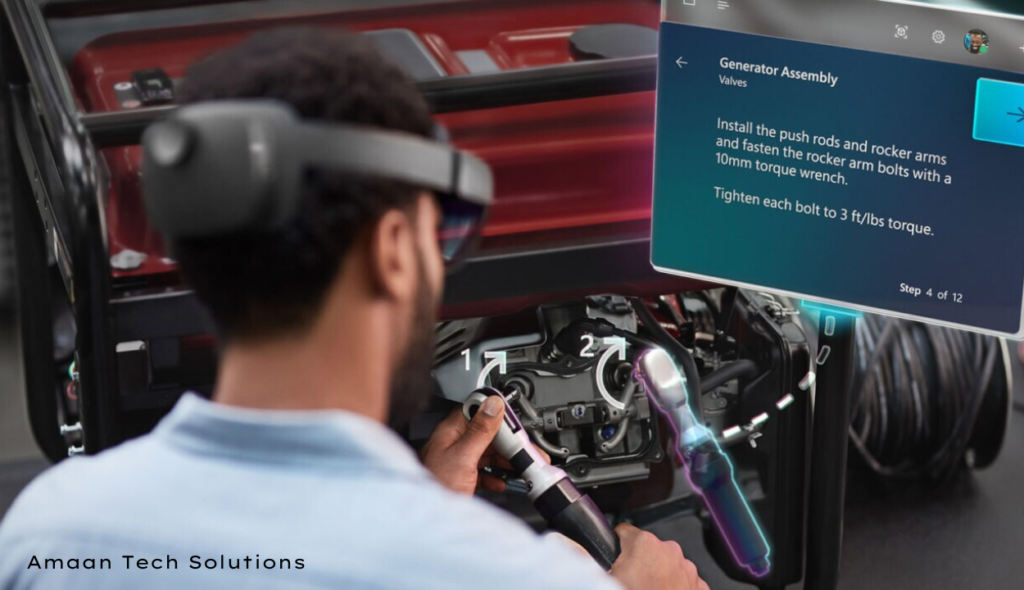
Future Prospects And Updates
Both Apple Vision Pro and HoloLens are positioned at the forefront of augmented reality (AR) technology. Their future prospects are shaped by ongoing advancements, strategic partnerships, and evolving market demands.
Apple Vision Pro
Apple’s commitment to the Vision Pro is evident through continuous updates and a robust roadmap. The following points highlight the anticipated developments:
- Software Updates: Regular updates to the core operating system, enhancing performance, introducing new features, and improving user experience.
- Hardware Advancements: Potential incorporation of more advanced sensors, improved battery life, and more refined ergonomics.
- Developer Support: Expansion of the Vision Pro SDK, allowing developers to create more immersive applications and utilize ARKit advancements.
- Integration with Apple’s Ecosystem: Greater integration with other Apple products such as the iPhone, iPad, and Mac, providing a more seamless experience.
HoloLens
Microsoft continues to push the boundaries with HoloLens, characterized by its dedication to innovation and enterprise solutions. Upcoming developments for HoloLens include:
Mixed Reality Services
Enhancement of Microsoft’s mixed reality services to support more complex and detailed environments.
AI Integration
Increased integration of artificial intelligence to provide smarter, more intuitive interactions.
Enterprise Solutions
Expanding partnerships with industries such as manufacturing, healthcare, and education, to tailor solutions to specific enterprise needs.
Enhanced Development Tools
Improvements in the Mixed Reality Toolkit (MRTK), making it easier for developers to build sophisticated applications.
Industry Trends
Several industry trends are influencing the trajectory of both Apple Vision Pro and HoloLens:
5G Connectivity
The proliferation of 5G networks is expected to enable more robust AR experiences by reducing latency and increasing data throughput.
Cloud Computing
Increased reliance on cloud computing to handle complex processing tasks, thereby enhancing device performance.
Wearable Tech Integration
Broader integration of AR capabilities into everyday wearable tech, potentially leading to smaller, lighter devices.
Consumer and Enterprise Adoption
Growth in both consumer interest and enterprise adoption of AR technology, driven by compelling use cases and proven return on investment (ROI).
These factors indicate a dynamic landscape for AR technology, with both Apple Vision Pro and HoloLens poised to evolve rapidly in response to technological innovations and market needs.

Frequently Ask Question On Apple Vision Pro Vs HoloLens
What Is The Primary Difference Between Apple Vision Pro And HoloLens ?
Apple Vision Pro focuses on augmented reality (AR) and virtual reality (VR), bridging both with a mixed-reality experience. HoloLens primarily emphasizes augmented reality, projecting digital content onto the real world.
Which Device Offers Better Display Quality ?
Apple Vision Pro is expected to offer higher display quality with advanced OLED technology, delivering superior resolution and vivid colors. HoloLens uses holographic lenses that provide a different display experience, optimized for AR applications.
Which Device Is More Comfortable For Extended Use ?
Comfort largely depends on individual preferences. The Apple Vision Pro aims for a sleek design and ergonomic fit. HoloLens, while slightly bulkier, includes balanced weight distribution for prolonged use.
What Are The Main Use Cases For Each Device ?
- Apple Vision Pro:
- Immersive gaming
- VR experiences
- Professional creative work
- HoloLens:
- Industrial applications
- Real-time collaboration
- Training and education programs
How Do The User Interfaces Differ ?
Apple Vision Pro integrates with iOS, using a familiar interface enhanced for both AR and VR environments. HoloLens operates on Windows Mixed Reality platform, offering a more AR-centered interface with gesture and voice controls.
What Is The Price Range For Each Device ?
Apple Vision Pro: Expected to be premium-priced, likely in the range of high-end VR headsets.
HoloLens: Relatively expensive, around $3,500, due to its advanced AR capabilities and target professional market.
Are There Any Subscription Services Required ?
Apple Vision Pro might require subscriptions for certain apps or iCloud services. HoloLens does not have mandatory subscriptions, but additional enterprise services may incur costs.
Can They Be Used Independently, Or Do They Require External Devices ?
Both devices are designed to function independently without needing external devices. Apple Vision Pro focuses on untethered usage, while HoloLens also supports standalone operation with built-in processing capabilities.
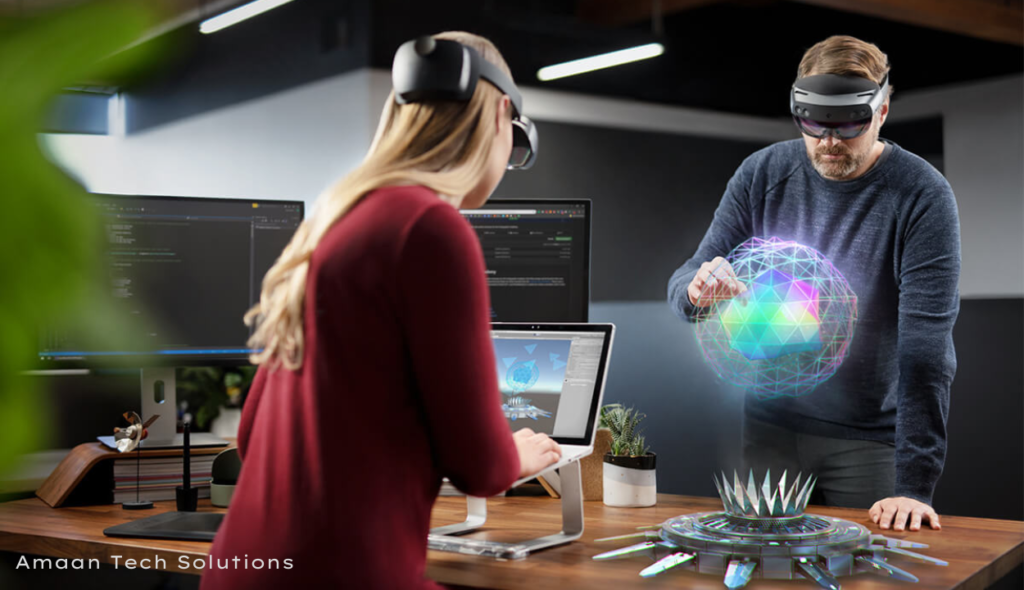
Conclusion
- In conclusion, both the Apple Vision Pro and Microsoft’s HoloLens represent significant advancements in the field of augmented reality (AR) and mixed reality (MR) technologies, catering to different segments of users and use cases.
- The Apple Vision Pro, with its seamless integration into the Apple ecosystem, offers a sleek design and a user-friendly interface that appeals to consumers and professionals alike.
- Its advanced display technology and spatial audio capabilities create an immersive experience that is ideal for entertainment, communication, and productivity applications.
- The Vision Pro’s emphasis on privacy and intuitive control mechanisms, such as eye tracking and hand gestures, further enhance its appeal.
- On the other hand, Microsoft’s HoloLens is positioned as a powerful tool for enterprise and industrial applications. It boasts robust hardware and software designed to support complex, hands-free tasks in sectors such as manufacturing, healthcare, and education.
- The HoloLens is known for its reliable spatial mapping, precise hand tracking, and integration with Microsoft’s suite of enterprise solutions, making it an invaluable asset for businesses looking to improve efficiency and collaboration.
- Ultimately, the choice between the Apple Vision Pro and HoloLens depends on the user’s needs and priorities. For consumers and professionals seeking a versatile and immersive AR experience within the Apple ecosystem, the Vision Pro is an excellent choice.
- For enterprises looking to leverage AR for specific industrial applications and benefit from Microsoft’s enterprise ecosystem, the HoloLens stands out as the preferred option. Both devices showcase the future potential of AR/MR technologies, each excelling in their respective domains.

Amaan Warraich is a tech fanatic and creator enthusiastic about exploring the ultra-modern advancements in technology. With a background in laptop technological know-how, Amaan delves into topics ranging from synthetic intelligence to cybersecurity, aiming to make complex concepts accessible to all. Through his paintings, he strives to encourage interest and innovation inside the ever-evolving global of generation.

